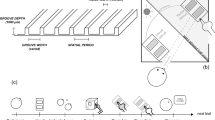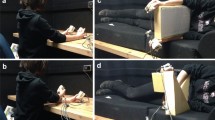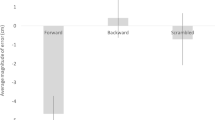Abstract
The visual system uses several signals to deduce the three-dimensional structure of the environment, including binocular disparity, texture gradients, shading and motion parallax. Although each of these sources of information is independently insufficient to yield reliable three-dimensional structure from everyday scenes, the visual system combines them by weighting the available information; altering the weights would therefore change the perceived structure. We report that haptic feedback (active touch) increases the weight of a consistent surface-slant signal relative to inconsistent signals. Thus, appearance of a subsequently viewed surface is changed: the surface appears slanted in the direction specified by the haptically reinforced signal.
This is a preview of subscription content, access via your institution
Access options
Subscribe to this journal
Receive 12 print issues and online access
$209.00 per year
only $17.42 per issue
Buy this article
- Purchase on Springer Link
- Instant access to full article PDF
Prices may be subject to local taxes which are calculated during checkout




Similar content being viewed by others
References
Backus, B. T., Banks, M. S., van Ee, R. & Crowell, J. A. Horizontal and vertical disparity, eye position, and stereoscopic slant perception. Vision Res. 39, 1143–1170 (1999).
Blake, A., Bülthoff, H. H. & Sheinberg, D. Shape from texture: ideal observer and human psychophysics. Vision Res. 33, 1723 –1737 (1993).
Buckley, D. & Frisby, J. P. Interaction of stereo, texture and outline cues in the shape perception of three-dimensional rigids. Vision Res. 33, 919–933 (1993).
Johnston, E. B., Cumming, B. G. & Parker A. J. Integration of depth modules: Stereopsis and texture. Vision Res. 33, 813–826 (1993).
Landy, M. S., Maloney, L. T., Johnston, E. B. & Young, M. Measurement and modeling of depth cue combination: in defense of weak fusion. Vision Res. 35, 389–412 (1995).
Clark, J. J. & Yuille, A. L. Data Fusion for Sensory Information Processing Systems (Kluwer, Boston, 1990).
Bülthoff, H. H. & Yuille, A. L. in Attention Performance XVI: Information Integration in Perception and Communication (eds. McClelland, J. & Inui, T.) 3 49–70 (MIT Press, Cambridge, Massachusetts, 1996).
Knill, D. C. Discrimination of planar surface slant from texture: human and ideal observers compared. Vision Res. 38, 1683– 1697 (1998).
van Ee, R., Banks, M. S. & Backus, B. T. An analysis of binocular slant contrast. Perception 28, 1121–1145 (1999).
Rogers, B. J. & Bradshaw, M. F. Disparity scaling and the perception of frontoparallel surfaces. Perception 24, 155–179 (1995).
Bradshaw, M. F., Glennerster, A. & Rogers, B. J. The effect of display size on disparity scaling from differential perspective and vergence cues. Vision Res. 36, 1255–1264 (1996).
Backus, B. T. & Banks, M. S. Estimator reliability and distance scaling in stereoscopic slant perception. Perception 28, 217–242 (1999).
Rock, I. & Victor, J. Vision and touch: An experimentally created conflict the two senses. Science 143, 595–569 (1964).
Gibson, J. J. Adaptation, after-effect, and contrast in the perception of curved lines. J. Exp. Psychol. 16, 1– 31 (1933).
Rock, I. The Nature of Perceptual Adaptation (Basic Books, New York, 1966).
Festinger, L., Burnham, C. A., Ono, H. & Bamber, D. in Journal of Experimental Psychology Monograph Vol. 74, No. 4 (American Psychological Association, Washington., 1967).
Welch, R. B. & Warren, D. H. in Handbook of Perception and Human Performance (eds. Boff, K. R., Kaufman, L. & Thomas, J. P.) 25.1–25.36 (Wiley, New York, 1986).
Lederman, S. J. & Abbott, S. G. Texture perception: studies of intersensory organization using a discrepancy paradigm, and visual versus tactual psychophysics. J. Exp. Psychol. Hum. Percept. Perform. 7, 902–915 ( 1981).
Harris, C. S. Perceptual adaptation to inverted, reversed, and displaced vision. Psychol. Rev. 72, 419–444 (1965).
Welch R. B. Perceptual Modification: Adapting to Altered Sensory Environments (Academic, New York, 1978).
Stratton, G. M. Vision without inversion of the retinal image. Psychol. Rev. 4, 341–360, 463–481 (1897).
von Helmholtz, H. Handbuch der Physiologischen Optik Vol. III (Leopold Voss, Leipzig, 1867).
Walk, R. D. Intersensory perception and sensory integration. (Plenum, New York, 1981).
Massie T. & Salisbury, J. K. in Dynamic Systems and Control 1994 Vol. 55 (ed. Radcliffe, Clark J.) 295– 301 (American Society of Mechanical Engineers, New York, 1994).
Gillam, B. Stereoscopic slant reversals: a new kind of 'induced' effect. Perception 22, 1025–1026 (1993).
Acknowledgements
This research was supported by NSF grant (DBS-9309820) and AFOSR grant (93NL366) to M.S.B. and by the Max-Planck Society. The authors thank Robert Cooper and Mike Landy for comments.
Author information
Authors and Affiliations
Corresponding author
Rights and permissions
About this article
Cite this article
Ernst, M., Banks, M. & Bülthoff, H. Touch can change visual slant perception. Nat Neurosci 3, 69–73 (2000). https://doi.org/10.1038/71140
Received:
Accepted:
Issue Date:
DOI: https://doi.org/10.1038/71140
This article is cited by
-
Do observers use their own interpupillary distance in disparity scaling?
Optical Review (2023)
-
The influences of target size and recent experience on the vigour of adjustments to ongoing movements
Experimental Brain Research (2022)
-
The structure of the superior and inferior parietal lobes predicts inter-individual suitability for virtual reality
Scientific Reports (2021)
-
Comparison of two psychophysical methods across visual and haptic perception of stand-on-ability
Psychological Research (2020)
-
Orientation-specific learning of the prior assumption for 3D slant perception
Scientific Reports (2018)



